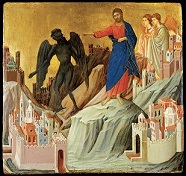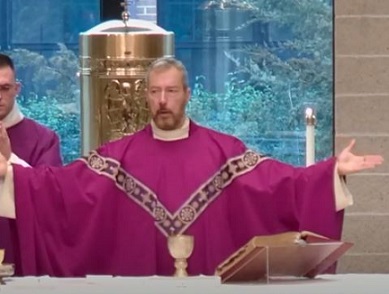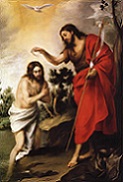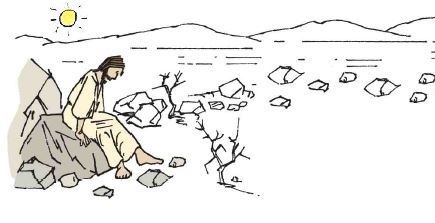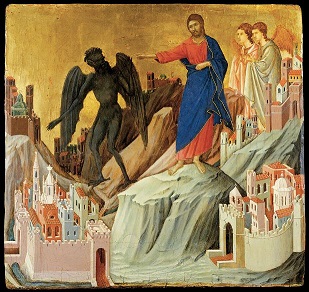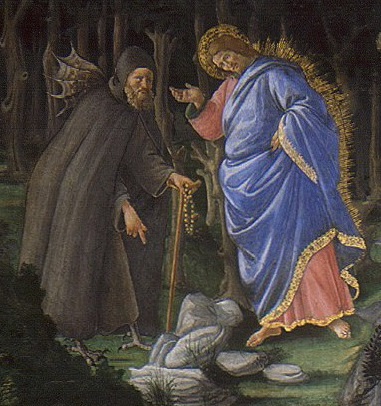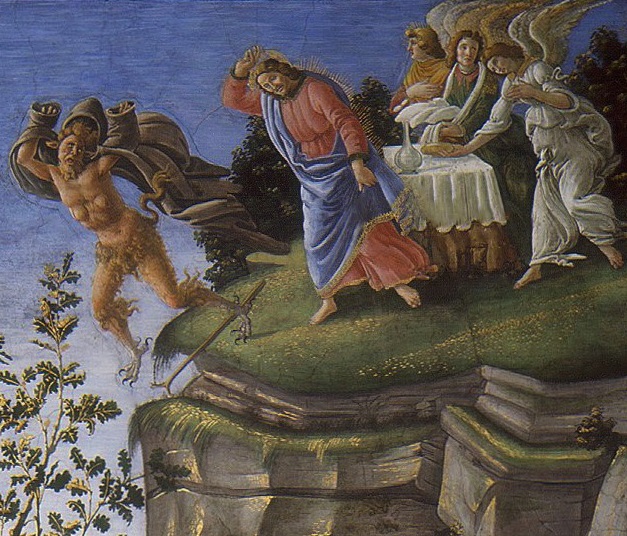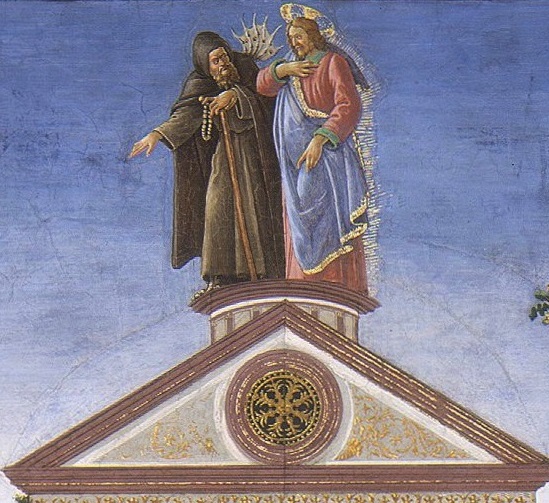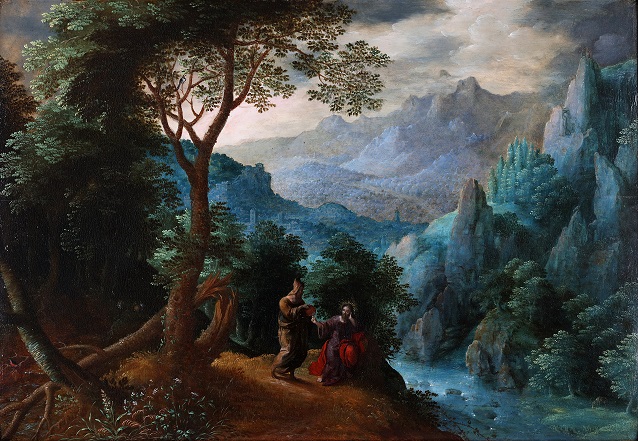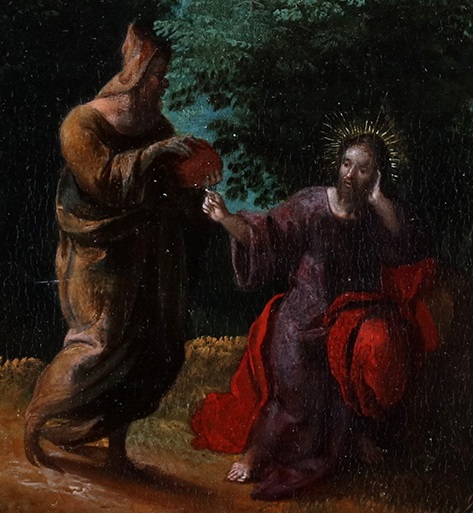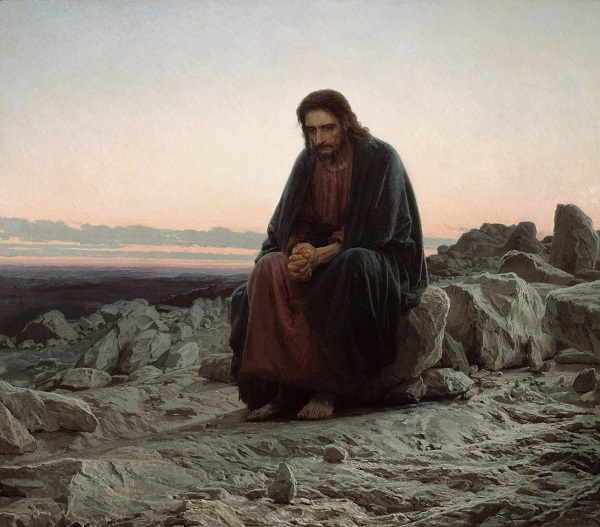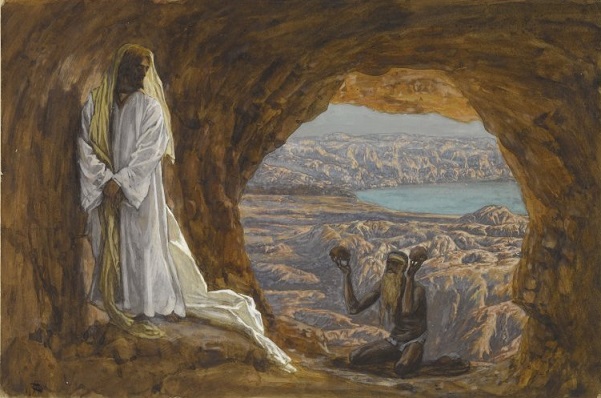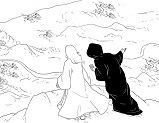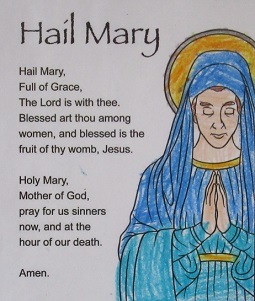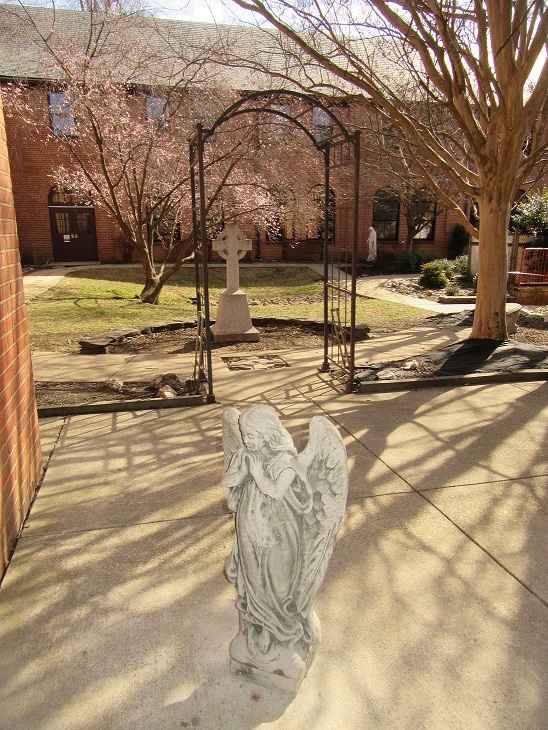Let’s begin with the Sign of the Cross:
We are in the season of Lent now. Wherever you were at Mass on Sunday, the priest was wearing a purple chasuble. Lent is the time before Easter. It is one of the two purple seasons of the Church calendar. This is Father Giese on Sunday, in a purple chasuble: GOSPEL: At Mass this weekend, the Gospel
reading was from the Gospel of Luke. The story is called
“The Temptation of Jesus.” For children, a
confusing part of hearing about the Temptation of Christ
can be that we are sort of doing a “flash back”
in the story of Jesus’ life. A “flash
back” is like this: Imagine that you are telling a
story about something that happened to you during 1st
grade. But then, in order to better explain what
happened, you must explain something that happened during
the year before 1st grade.
ASK: Are there times when you are tempted to do wrong, but you know that you should not do wrong? What can you do to avoid the temptation? ART: Many artists have painted about this part of Jesus' life, when he was in the wilderness for 40 days. Below are some of those paintings. If you click a picture, you will see a much larger version. For some of the pictures, you can click on the larger version and see an even LARGER version. The first painting was made in about 1300, by the artist named Duccio di Buoninsegna. The painting is called "Temptation on the Mountain." It is part of a large piece of art called "Maestą." This painting is on the backside of the large piece of art (the Maestą), and it is next to another painting that we looked at before, a painting about when Jesus called Andrew and his brother Simon Peter to be Apostles, to be fishers of men. The large piece of art was made to be put on an altar inside a huge church building in Italy. The piece of art had two sides, and it had different paintings on each side. (Side 1.) (Side 2.) The art piece was in that church for about 450 years. Then, the large piece of art was cut into pieces, leaving many individual paintings, and the individual paintings are now in many places around the world. The next painting was made in the year 1482, by Sandro Botticelli. It is a fresco, and it is painted on a wall at the Sistine Chapel, in Rome, Italy. It is called "Temptation of Christ." It is 18 feet wide and 11 feet high, larger than the end wall in the classroom. There are many things happening in the painting. Let's look at three parts of the painting. We'll begin in the upper-left corner of the painting. In that corner, the artist painted the devil coming to Jesus when he was in the wilderness for 40 days. Jesus was hungry. The devil tempted him by saying, "If you are the Son of God, tell this stone to become bread." Here is that portion of the painting. The devil is portrayed as pretending to be a man, but you see his feet that look like bird feet. The devil is pointing to stones on the ground.
In the upper-right corner, the artist
painted the devil in a high place with Jesus, looking
down over many towns and cities, and the devil said,
"If you worship me, it will all be yours."
In the center of the painting, at the
top, the artist painted the devil and Jesus standing on
the highest point of the temple in Jerusalem, where the
devil said to Jesus, "If You are the Son of God,
throw Yourself down from here." The devil said that,
if Jesus was the Son of God, God would tell angels to
protect Jesus, so that Jesus would not fall to the
ground.
The next painting was made in about 1502, by Juan de Flandes. It is small, only about eight inches high and about six inches wide. It's at the National Gallery of Art in Washington, D.C. It's an oil painting. The next painting was made in 1600, a little over 400 years ago. The artist's name was Tobias Verhaecht, and the painting is called "The Temptation of Christ." It's an oil painting, about two feet wide and almost a foot-and-a-half high. The artist liked to paint mountains and landscapes. Jesus and the devil are the smallest part of the painting. Here is a close-up of the devil trying to tempt Jesus The devil is holding a large brick of gold. Look at the devil's feet: They look like the feet of a goat.
The next painting was made in 1872, by Ivan Nikolaevich Kramskoi. The painting is called "Christ in the Wilderness." The painting is six feet high and seven feet wide. It is in an art gallery in Moscow, Russia. The next painting was made in 1890, by James Tissot. The painting is called "Jesus Tempted in the Wilderness." Jesus appears to be inside a cave. The devil is kneeling on the ground outside the cave, holding up stones. The painting is gouache on paper. Gouach is kind of like watercolor paint, but it's thicker. This art is at a museum in Brooklyn, New York. It's about 13 inches wide and about nine inches high. SNACK: Remember our
prayer before meals? Brother Francis video (# 9): What
is Prayer? Prayer is more than just telling God
what we want or need. TEXTBOOK: This week
we’ll do Lesson # 16. It begins on page 145. And
like the Brother Francis lesson, the textbook lesson is
called, "What is prayer?" Let's turn to page
145. SAINT FEATURED IN CHAPTER: Two of Monica's three children did well, but her son Augustine was lazy and rude. When Monica's son Augustine was 17 years old, Monica sent him away to school. While at school, he began following a religion that was not the Christian religion. Then he returned to his mother's home and told her that he followed the new religion. Monica was sad that her son had not become a Christian, and she told him to leave her home. After some time, Monica made up with her son. Monica followed her son around the country for 17 years as he lived a wild life of parties and drinking. For 17 years, Monica prayed that her son would turn his life around and become a Christian. Finally, Augustine converted to Christianity. Her son was Saint Augustine, one of the greatest saints who ever lived.
COLORING SHEET: Luke 4:5-8 CLOSING PRAYERS: Time to say goodbye. :-) We'll begin with the Our Father.
|
